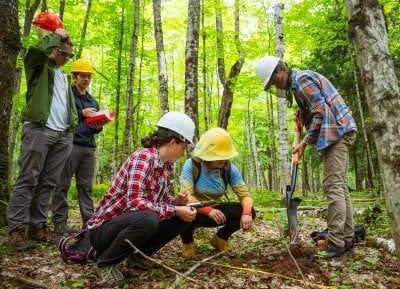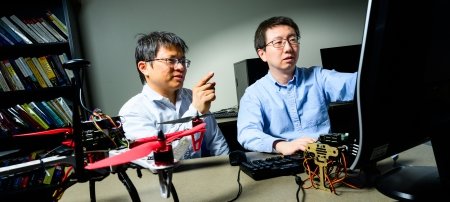Environmental data science is the latest addition to Michigan Technological University undergraduate programs that teach students how to visualize, manage and understand data to find solutions for urgent global challenges.
The potential power of environmental data science hit David Flaspohler, dean of Michigan Tech's College of Forest Resources and Environmental Science (CFRES), about four years ago during a conversation with his daughter. She was in the computer science Ph.D. program at the Massachusetts Institute of Technology doing research that involved predicting the location of deep-sea thermal vents. The vents lie hundreds of feet below the surface of the Gulf of California in complete darkness, where they support a unique ecosystem.
"She was using environmental data collected from remotely operated vehicles that sample ocean chemistry to allow her to trace the diluting water from each vent back to its origin," Flaspohler said. "It was kind of an 'aha!' moment when I saw how this kind of environmental data could help address a lot of questions in the natural resources field."
The first students to enroll in the bachelor's degree in environmental data science program will begin their coursework in fall 2024. Proponents of the new degree program said Michigan Tech's distinctive academic and physical environments are ideally suited for this category of data science studies.
For instance, environmental data science can answer questions about how forests respond to climate change related to temperature, moisture or invasive pests. Data science was also used to find out how the moose population of Isle Royale National Park reacted to the translocation of new wolves to the Lake Superior island in 2018.
Michigan Tech has a rich tradition of innovative cross-disciplinary programs, and environmental data science students will find themselves at the forefront of this exciting new field.

"Sixty-four moose were fitted with GPS collars that send location information every 30 minutes," said Flaspohler. "This amounts to 4,383 locations per moose per year. In addition, the collars contain a thermometer and an accelerometer that records the 3D movement of each moose every five minutes, or 105,192 times per year. This research has resulted in literally millions of data points related to location, temperature, habitat use, activity levels and more."
"Traditional statistical approaches often fail to identify highly complex patterns while tools from data science can prove useful," said Flaspohler.
Data Science Infused Across Tech's Campus
While the new environmental data science bachelor's degree is housed in MTU's College of Forest Resources and Environmental Science, it's part of a collaboration between CFRES, the departments of Biological Sciences and Mathematical Sciences in the College of Sciences and Arts, and the College of Computing.
Connections Across Colleges
Data science factors into everyday life as well as work environments around the world. That's why all of Michigan Tech's colleges collaborate on numerous data science programs and projects. The University's information technology department, as well as Van Pelt and Opie Library, are also partners.
Laura Brown, associate dean of data science initiatives in Michigan Tech's College of Computing and director of its data science master's and bachelor's degree programs, said the possibilities for cross-collaboration are as limitless as data itself.
"Now that we have all of this data to help us understand the world, we have to think about how we collect it, process it, manage it and how we can model the world with it to ultimately lead to insights and new knowledge," she said.
Like the latest programs at Tech, data science as its own discipline is a relatively new development. Brown, who is also an associate professor of computer science, watched the field emerge during her own years as a student.
While she was excited by the potential and always knew she wanted to be involved, Brown has been surprised by the rapid pace and amount of growth in the relatively new field.
"I don't know if I envisioned the growth to the extent of what it is. I consider myself more of a cynical person," she said, laughing. "But at Michigan Tech, I was among a group that started discussing data science back in 2012. We put together a proposal for the master's in data science program, which was approved to start in fall 2014. The University was among the leaders in terms of thinking about creating educational programs in this space. At the time, these programs were typically master's programs. Since then, there's been a definite growth in recognition across communities about what data science is and what data science education is. I'm glad we're able to offer the bachelor's in data science, which began in 2023, and now the environmental data science program as well."
Using words like "exciting" to describe data science may seem antithetical to those accustomed to the stereotype of computational-based professions. But the typecast lone figure staring at a computer screen in a dark room is not the day-to-day reality, said Brown.
"Sure, there may be some of that, but when you think about data science in practice, in industry and research, this is not someone in isolation," she said. "This is working in teams, on projects. Especially if you're working with experts in a particular domain. You're going to have teams of people working together to understand the problems and how to solve them — to understand what their data is really saying."
"It's really important that people are not just thinking, 'I have this data.' They're thinking, 'Should I have this data?' or 'Should I solve this problem?' We're making sure our students are thinking about these questions."
The demand for data scientists is huge because of the ability to collect and analyze data on a more massive scale than ever before across domains and industries, said Brown. Growth in computational resources parallels the trend.
"There are jobs out there and there will be more jobs because there is so much data being created, and it's not always being analyzed or understood," she said. "Many industries are still growing and need people to understand and work with their data: manufacturing companies, insurance, finance, health care — all of these different domains have lots of different data that they need to understand. They need to have systems in place to process it and answer questions, both internally and externally."
Why Study Data Science at Michigan Tech?
With Michigan Tech's 3,650-acre research forest, dozens of ongoing research projects and ample opportunities for student participation, including fellowships and fieldwork practicums, there's no better place than the Keweenaw Peninsula to dive into environmental data science, said Flaspohler.
$119,040
U.S. Bureau of Labor Statistics
3rd
U.S. Bureau of Labor Statistics
No. 4
U.S. News & World Report
"What's unique about the environmental data science program is that students will get experience collecting the data that they'll be analyzing," said Flaspohler. "This will give them a detailed understanding of how the data is structured, what possible biases are part of the data structure and how the analyses can be tailored to get the most value from the data."
More broadly, what students can focus on in any of Michigan Tech's data science courses is as varied as the students themselves, said Brown. In addition to learning core programming techniques and data analysis, students can customize programs to suit their interests.
"I hope that students feel welcome coming from interests across the University and all sorts of different backgrounds," she said. "One of the things I really like about how we have designed the bachelor's of data science here is that we have a set core of courses that involve computer science, math and statistics, but also include communication, context and ethics."
Brown said each student can also choose a technical focus area that gives them a minor. "A student's minor could be close to the core — say, a minor in computer science, statistics, business or cybersecurity — but we also expect those options to grow, and so we have a build-your-own option as well. For example, if a student is really passionate about biology, I know data science will be incredibly useful for them. We can bring in that disciplinary knowledge to what they're passionate about and what they want to learn in physics, in chemistry, in humanities. There's a whole area of work in digital humanities thinking about analyzing text — and other areas — in which data science is extremely useful."
Not everyone is going to major in data science, but I firmly believe that everyone on this campus could take a data science course and benefit from it. That would be my desire.

Brown's wide-ranging research interests demonstrate the boundless opportunities available to students exploring data science.
"I have always wanted to be involved with different research questions in different areas," she said. "This is one of the reasons I'm so happy to work in this space. I have projects where I collaborate with folks from electrical, computer and mechanical engineering working on questions related to energy systems. I have projects with folks from chemistry, chemical engineering, forestry, civil and environmental engineering — I feel like I'm always learning something." Brown said collaborating on projects across a multidisciplinary spectrum also leads to insights about how to better work with different types of data or make computational improvements. "There's learning in both directions, which is great," she said.
Data Science for Everyone, Everywhere
The environmental data science program at Tech is a prime example of how students can customize their studies in the discipline. There are four tracks: Global Change Science, Environmental Statistics, Geographic Information Science and Genetic Applications of Data Science.

"Global Change Science prepares students to tackle big questions related to climate change and other environmental changes, including biodiversity loss, wildland fire, biogeochemistry and climate refugia," said Flaspohler. "Students will learn about the forces driving environmental change as well as the tools and policies we can use to mitigate harmful change."
Students choosing the Environmental Statistics track will use software like R and Python to take large, complex environmental datasets and, with their understanding of experimental design, data collection protocols and analysis, test hypotheses to answer important environmental questions.
The track in Geographic Information Science focuses on skills to visualize and analyze geospatial data collected by satellites, drones and aircraft. "GIS is a powerful and fast-growing technology used in a diverse range of environmental fields, from agriculture and forestry to ocean and atmospheric sciences," said Flaspohler.
The Genetic Applications of Data Science track enables students to use genetic data, including genomics and bioinformatics, to explore questions related to conservation, inbreeding, population structure and evolution.
One of Brown's favorite aspects about working with her students in the College of Computing is how Huskies avidly pursue their interests beyond coding and computation, including athletics, campus organizations and music. "They're engaged and I think they're excited to learn," said Brown. "Our program opens up different avenues. We want students to find their interest, their passion, and their expertise, whether that be in data science or somewhere else. They're going to be able to take the skills they learn and transfer those no matter where they go."
Michigan Technological University is an R1 public research university founded in 1885 in Houghton, and is home to nearly 7,500 students from more than 60 countries around the world. Consistently ranked among the best universities in the country for return on investment, Michigan's flagship technological university offers more than 185 undergraduate and graduate degree programs in science and technology, engineering, computing, forestry, business, health professions, humanities, mathematics, social sciences, and the arts. The rural campus is situated just miles from Lake Superior in Michigan's Upper Peninsula, offering year-round opportunities for outdoor adventure.






Comments